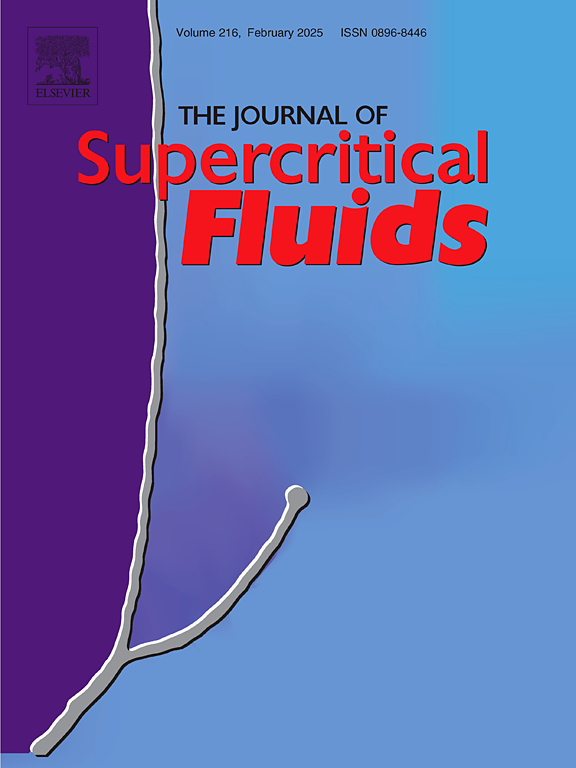将巴巴蒂旺树皮提取物高压液体浸渍到由 PBS/PLA 和 Cloisite 20 A 混合物组成的生物聚合物膜中
IF 3.4
3区 工程技术
Q2 CHEMISTRY, PHYSICAL
引用次数: 0
摘要
巴巴蒂芒树皮提取物因其药用特性而闻名,其中含有易降解的生物活性化合物,因此需要将其置于稳定的基质中,以实现各种生物医学应用。本研究采用高压液体浸渍(HPLI)技术,在 30、45 和 60 °C、11 兆帕的压力下将巴巴蒂旺萃取物注入生物聚合物膜。HPLI 结合了直接浸渍的简便性和高压下更高的传质速率。使用电纺丝技术制作了由聚丁二酸丁二醇酯(PBS)、聚乳酸(PLA)和 Cloisite 20 A(C20A)组成的生物聚合膜,其成分为 50/45/5(v/v)。与传统方法的比较分析,以及利用扫描电镜、傅立叶变换红外光谱和热重分析对浸渍膜特性的评估,都证明了 HPLI 的有效性。HPLI 的酚类化合物负载量明显较高,在 11 兆帕和 45 °C、6 小时内达到 43.79 毫克 ETA/g 膜的峰值,而传统浸渍法在环境压力和 45 °C、相同时间内达到 25.44 毫克 ETA/g 膜的峰值。本文章由计算机程序翻译,如有差异,请以英文原文为准。
High-pressure liquid impregnation of barbatimão bark extract into biopolymeric membrane composed of PBS/PLA and Cloisite 20 A blend
Renowned for its medicinal properties, barbatimão bark extract contains bioactive compounds susceptible to degradation, necessitating their safeguarding within a stable matrix for diverse biomedical applications. This study investigates using high-pressure liquid impregnation (HPLI) to load barbatimão extract into biopolymeric membranes at 30, 45, and 60 °C, and 11 MPa. HPLI combines the simplicity of direct immersion with improved mass transfer rates under high pressure. Biopolymeric membranes made from poly(butylene succinate) (PBS), poly(lactic acid) (PLA), and Cloisite 20 A (C20A) in a 50/45/5 (v/v) composition were created using electrospinning. Comparative analysis with conventional methods, along with evaluation of impregnated membrane properties using SEM, FTIR, and thermogravimetric analysis, demonstrated the effectiveness of HPLI. HPLI yielded markedly higher phenolic compound loadings, peaking at 43.79 mg ETA/g membrane at 11 MPa and 45 °C over 6 h, compared to 25.44 mg ETA/g membrane with conventional impregnation at ambient pressure and 45 °C over the same duration.
求助全文
通过发布文献求助,成功后即可免费获取论文全文。
去求助
来源期刊

Journal of Supercritical Fluids
工程技术-工程:化工
CiteScore
7.60
自引率
10.30%
发文量
236
审稿时长
56 days
期刊介绍:
The Journal of Supercritical Fluids is an international journal devoted to the fundamental and applied aspects of supercritical fluids and processes. Its aim is to provide a focused platform for academic and industrial researchers to report their findings and to have ready access to the advances in this rapidly growing field. Its coverage is multidisciplinary and includes both basic and applied topics.
Thermodynamics and phase equilibria, reaction kinetics and rate processes, thermal and transport properties, and all topics related to processing such as separations (extraction, fractionation, purification, chromatography) nucleation and impregnation are within the scope. Accounts of specific engineering applications such as those encountered in food, fuel, natural products, minerals, pharmaceuticals and polymer industries are included. Topics related to high pressure equipment design, analytical techniques, sensors, and process control methodologies are also within the scope of the journal.
 求助内容:
求助内容: 应助结果提醒方式:
应助结果提醒方式:


